Raising a Giant Angora rabbit is a rewarding experience for anyone who loves fluffy, affectionate pets. This breed stands out because of its thick, luxurious wool and gentle personality. Unlike other rabbits, Giant Angoras require dedicated grooming and specific care to keep them healthy and happy. Whether you’re interested in them as loving companions or for their high-quality wool production, understanding their needs will help you build a strong bond with your rabbit.
Giant Angoras are not just beautiful; they are also intelligent and social creatures. With the right approach, you can raise a rabbit that enjoys spending time with you and even seeks out attention. From setting up the perfect living space to providing the best diet, proper care plays a huge role in their well-being. This guide will walk you through everything you need to know about caring for a Giant Angora rabbit, from grooming and feeding to housing and bonding. By following these tips, you’ll create a comfortable environment where your rabbit can thrive—and love you back.
Understanding the Giant Angora Rabbit
What Makes the Giant Angora Unique?
The Giant Angora rabbit is the largest of all Angora breeds, known for its thick, soft wool that continuously grows. Unlike other rabbits, this breed has three different types of wool: soft underwool, awn fluff, and awn hair. This dense coat makes them highly prized for wool production, as they produce more fiber than any other Angora rabbit. Regular grooming is essential to prevent matting and ensure the rabbit stays comfortable.
In addition to their wool, Giant Angoras have a distinct appearance. They have a broad, sturdy body, large ears with fluffy tips, and a calm, sweet expression. Many owners describe them as gentle giants because of their size and docile temperament. Their relaxed nature makes them great pets for patient owners willing to invest time in their care.
Giant Angoras also differ from other rabbits in their growth and maintenance. Unlike smaller Angora breeds, they require more food, space, and attention to keep their wool in top condition. Whether you raise them as a pet or for fiber production, their unique characteristics make them a fascinating breed to own.
Lifespan and Personality Traits
A Giant Angora rabbit can live between 7 to 12 years, depending on genetics, diet, and overall care. Providing a nutritious diet, proper grooming, and regular vet checkups can help extend their lifespan. Unlike some smaller rabbit breeds that tend to be skittish, Giant Angoras are known for their calm and affectionate personalities.
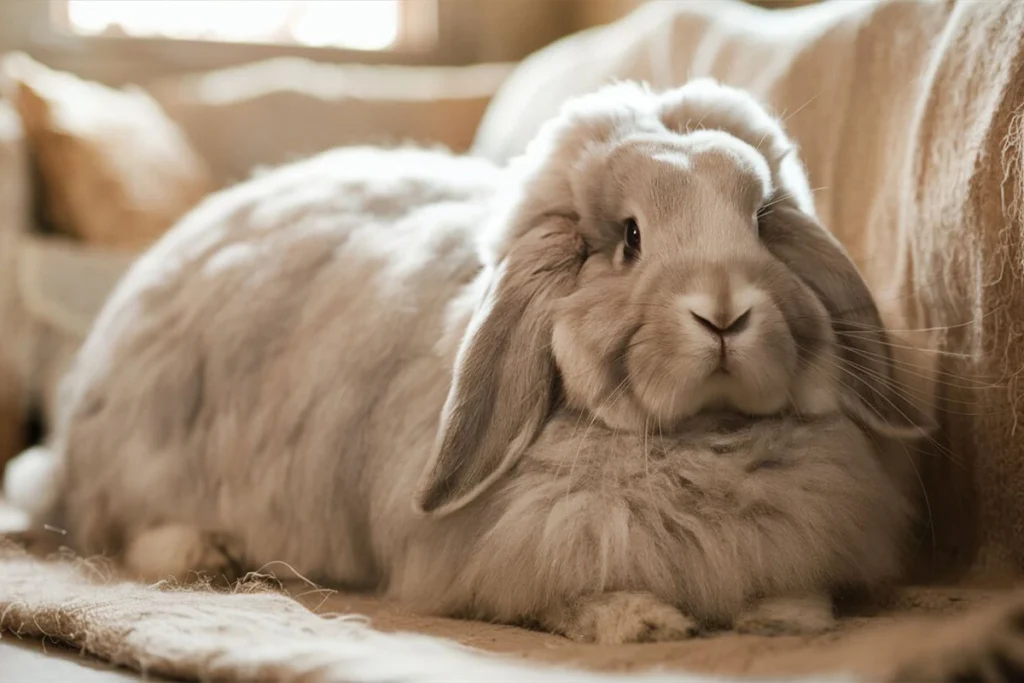
These rabbits enjoy human interaction and can form strong bonds with their owners. They appreciate gentle handling and often respond well to consistent care and attention. Some even seek out affection by nudging their owners or sitting quietly beside them. Although they are friendly, they still need proper socialization from a young age to feel comfortable around people.
Giant Angoras are also intelligent and curious. They enjoy exploring their environment, playing with toys, and even learning simple tricks. Owners who spend time interacting with their rabbits will notice their playful and inquisitive nature. However, because of their thick wool, they may not be as active as short-haired breeds and often prefer lounging in comfortable spots.
Comparing the Giant Angora to Other Long-Haired Rabbit Breeds
Several long-haired rabbit breeds exist, but the Giant Angora rabbit stands out because of its size, wool production, and temperament. Compared to the English Angora, which has fine, silky wool covering its entire body—including its face—the Giant Angora has a more manageable coat, with less facial wool. This makes grooming slightly easier, though both breeds require regular maintenance.
The French Angora has a softer coat with guard hairs that reduce matting, making it somewhat easier to maintain than the Giant Angora. However, it does not produce as much wool, making the Giant Angora the preferred choice for fiber production.
The Satin Angora differs because of its shiny, silk-like wool, which feels different from the dense, fluffy coat of a Giant Angora. While Satin Angoras are prized for their glossy fiber, they do not grow as much wool as their giant counterparts.
Another long-haired breed, the Jersey Wooly, is much smaller than the Giant Angora and is primarily kept as a pet rather than for fiber. While both breeds are affectionate and easygoing, the Jersey Wooly requires less grooming due to its shorter wool length.
In summary, the Giant Angora rabbit is the largest and most productive wool breed among long-haired rabbits. It requires more maintenance than some of its counterparts, but its calm temperament and impressive fiber output make it a fantastic choice for rabbit enthusiasts. Whether you want a loving pet or a high-yield fiber rabbit, the Giant Angora offers the best of both worlds.
Essential Care Tips for a Healthy Giant Angora Rabbit
Housing Requirements
Providing proper housing for your Giant Angora rabbit is crucial to their overall health and well-being. These rabbits thrive in spacious environments where they can move around freely. A large, well-ventilated hutch or enclosure is necessary to keep them comfortable. Ensure that the space is big enough for them to stretch out and hop around, as confinement to small areas can lead to stress and health issues.
When setting up the hutch, make sure it has a solid floor, as wire floors can cause injury to their sensitive feet. Adding soft bedding like straw or hay will not only provide comfort but will also help absorb urine, keeping the area clean and dry. Ensure the hutch is free from drafts and extreme temperatures, as Giant Angoras are more susceptible to heatstroke due to their dense coats. Ideally, house them in a cool, dry place that stays between 60–70°F (15–21°C).
If you house them indoors, provide them with a safe, enclosed space where they can roam and explore. Consider using exercise pens or a rabbit-safe room that allows them to interact with their environment without getting into trouble. If kept outdoors, make sure the hutch is predator-proof, with a secure door and mesh that will keep your rabbit safe from potential threats.
Best Food for Angora Rabbits
The diet of a Giant Angora rabbit plays a key role in their health, coat quality, and longevity. Like most rabbits, they should have unlimited access to fresh hay, such as timothy or meadow hay, which provides essential fiber for digestion. Fiber is especially important for Angoras to prevent wool block, a potentially dangerous condition where their ingested hair clogs their digestive tract.
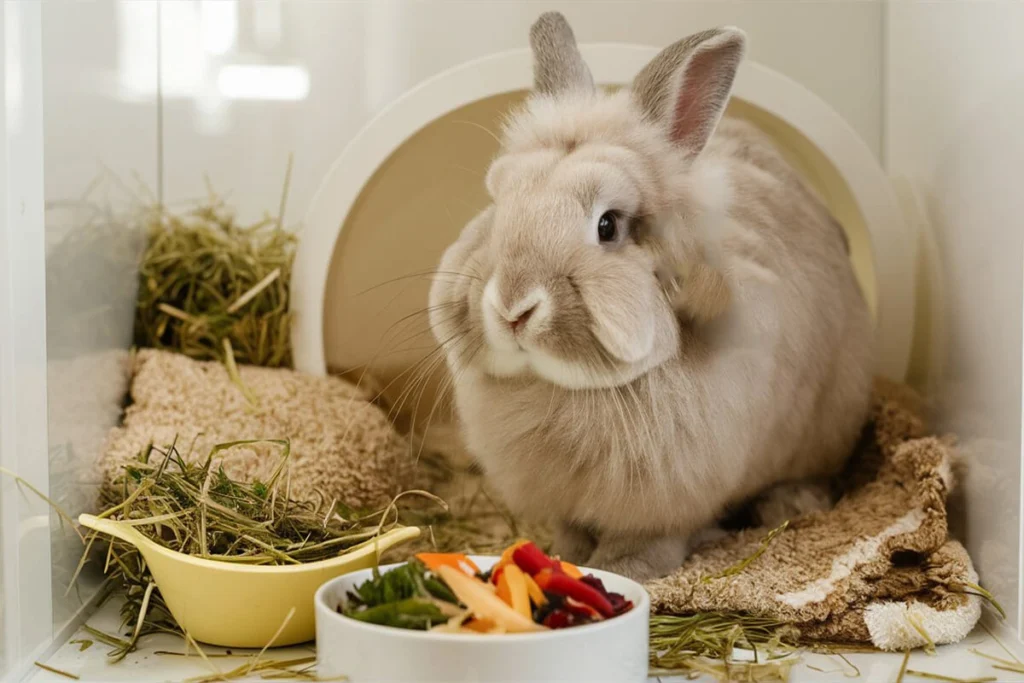
In addition to hay, provide fresh vegetables daily, such as leafy greens like romaine lettuce, dandelion greens, parsley, and cilantro. These vegetables offer important nutrients while helping to keep your rabbit hydrated. Avoid giving them iceberg lettuce, as it lacks nutritional value and can cause digestive upset. You can also introduce small portions of fresh fruit like apples or berries as treats, but limit sugary fruits to avoid digestive issues.
Giant Angoras also require a good quality rabbit pellet to supplement their diet. Choose a high-fiber pellet with no added sugars or seeds. Make sure to provide fresh water daily, and regularly clean their water bottle or bowl to ensure they have access to clean hydration.
Finally, consider adding a protein boost to their diet, particularly if you’re raising your Giant Angora for fiber production. Small amounts of high-protein foods like alfalfa hay or legumes can support their wool growth. However, monitor the amount carefully, as too much protein can lead to obesity or kidney issues.
Exercise and Enrichment
Though Giant Angora rabbits are not as active as some smaller breeds, they still require ample exercise and mental stimulation. Regular exercise helps prevent obesity, promotes healthy digestion, and keeps your rabbit mentally sharp. Provide an enclosed area or playpen where they can safely hop around, jump, and explore. Giving them a variety of toys like tunnels, cardboard boxes, or wooden chew toys can help keep them entertained and prevent boredom.
Interactive toys like treat-dispensing puzzles can engage their intelligence and provide a fun challenge. Because Giant Angoras are naturally curious, they enjoy exploring their surroundings, so set up a rabbit-friendly area where they can investigate new objects and safely interact with different textures and items.
Supervised outdoor time is also beneficial, but make sure the area is secure from predators. If you choose to let your rabbit roam in a safe outdoor space, use a rabbit harness or ensure the area is entirely fenced in to prevent them from running away.
Grooming sessions can also serve as a form of enrichment, especially if you make them a positive bonding experience. As you groom your Giant Angora’s coat, talk to them gently or offer treats to create positive associations with the process. Not only will this help maintain their wool, but it will also give them the physical touch and attention they crave.
In short, providing your Giant Angora rabbit with ample space to exercise, stimulating toys, and a variety of environments to explore will keep them both physically healthy and mentally happy. Regular interaction with their owners will also foster a strong bond, ensuring that your rabbit feels loved and secure.
Grooming Your Giant Angora Rabbit
How to Groom a Giant Angora Rabbit Properly
Grooming plays a crucial role in keeping your Giant Angora rabbit healthy and comfortable. Their dense, woolly coat requires regular care to prevent matting, reduce shedding, and minimize the risk of wool block. Aim to brush your rabbit at least three to four times a week, though daily brushing is ideal during high-shedding periods.
Use a slicker brush or metal-toothed comb to gently work through the thick layers of wool. Start at the base of the fur and work outward to remove tangles without pulling on the skin. Pay special attention to areas where matting commonly occurs, such as behind the ears, under the chin, and around the legs. If you encounter stubborn mats, carefully loosen them with your fingers before using a mat splitter or scissors with rounded tips. Never pull or yank at mats, as this can cause pain and stress.
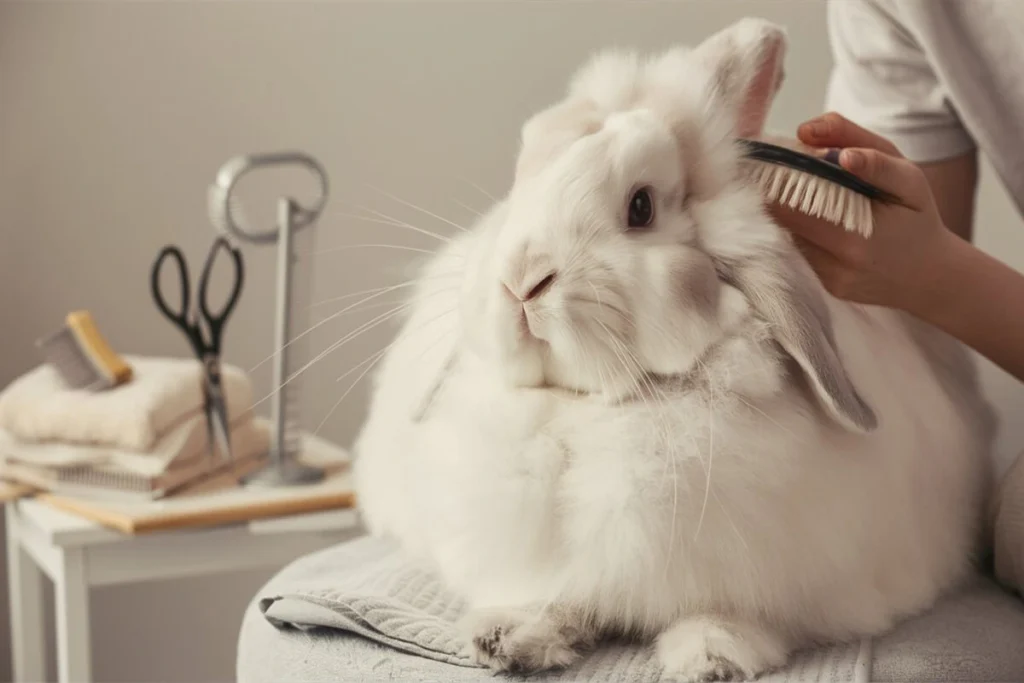
In addition to brushing, check your rabbit’s face, ears, and feet regularly. Wool can accumulate around their eyes and nose, leading to irritation. Take a wet cloth and clean off any dirt or dust. Trim their nails every few weeks to prevent overgrowth, which can cause discomfort and affect their ability to move properly.
Unlike some pets, Giant Angora rabbits should never be bathed unless absolutely necessary. Their thick fur takes a long time to dry, which can lead to chills and stress. Instead, use dry grooming techniques, such as cornstarch powder, to absorb oils and loosen dirt in their coat. Regular grooming not only maintains their wool but also strengthens the bond between you and your rabbit.
Shedding and Molting Management
Giant Angora rabbits experience natural shedding and molting cycles, which require extra grooming attention. Unlike short-haired rabbits, Angoras do not shed their fur evenly; instead, their wool comes out in clumps as new growth pushes out the old fibers. If left unmanaged, loose fur can lead to wool block, a dangerous condition where ingested hair accumulates in the digestive tract, causing blockages.
During heavy shedding periods, increase brushing to once a day to remove loose fur before your rabbit swallows it. In addition to brushing, provide plenty of fresh hay to help push any ingested fur through their digestive system. Fiber-rich foods like dandelion greens, cilantro, and papaya can further aid digestion and reduce the risk of wool block.
Observe your rabbit’s behavior closely during molting. If they become lethargic, lose their appetite, or produce fewer droppings, they may be suffering from wool block. Encourage more hay consumption and consult a veterinarian if symptoms persist.
Since shedding and molting can make your rabbit’s skin more sensitive, handle them gently and avoid excessive brushing in one area. If you notice dry skin or irritation, apply a small amount of rabbit-safe moisturizer or coconut oil to soothe the affected spots. Proper molting management ensures your rabbit stays comfortable while maintaining a healthy, clean coat.
Wool Production and Harvesting Tips
One of the most remarkable features of the Giant Angora rabbit is its wool production. This breed continuously grows long, soft fiber, making it a top choice for fiber enthusiasts and wool spinners. Unlike other Angoras, Giant Angoras do not naturally shed all their wool, so you must harvest their wool every 90–120 days to prevent matting and overgrowth.
You can use three main methods to harvest wool: plucking, clipping, or shearing. Plucking works best when the wool naturally releases during molting. Gently pull the loose fibers by hand, being careful not to tug on hair that is still attached. If the wool does not come out easily, use clipping or shearing instead.
Clipping involves using small scissors to cut the wool down to about an inch, while shearing requires electric clippers for faster removal. Regardless of the method, ensure you leave enough wool to keep your rabbit warm and comfortable. Always check for skin folds before cutting to avoid accidental injuries.
Once collected, store the wool in a breathable bag to prevent moisture buildup. If you plan to spin it into yarn, clean it thoroughly to remove dirt and excess oils before processing. Well-maintained Angora wool is highly sought after for its softness, warmth, and luxurious texture.
By regularly grooming, managing shedding cycles, and properly harvesting wool, you can keep your Giant Angora rabbit healthy while enjoying the benefits of their incredible fiber.
Common Health Concerns and How to Prevent Them
Signs of a Healthy Giant Angora Rabbit
A Giant Angora rabbit that receives proper care will display clear signs of good health. Observing their daily behavior, eating habits, and physical condition helps ensure they stay in top shape.
A healthy Giant Angora should have bright, alert eyes free of discharge or cloudiness. Their nose should be clean, without any mucus or signs of respiratory distress. Healthy rabbits breathe quietly without wheezing or sneezing. Their ears should be upright and free from excessive wax buildup, redness, or swelling, which could indicate an infection or mites.
The rabbit’s coat should feel soft, fluffy, and free of mats. A dull, patchy, or unkempt coat often signals underlying health problems or nutritional deficiencies. Regular grooming helps maintain the coat’s condition while preventing excessive shedding. Their skin should be smooth without signs of flaking, redness, or open sores. If you notice bald spots or excessive scratching, check for parasites or skin infections.
A rabbit in good health will have a consistent appetite and a well-functioning digestive system. They should eagerly eat hay, fresh vegetables, and pellets while drinking plenty of fresh water. Their droppings should be firm, round, and uniform in size. Any change in droppings—such as becoming small, misshapen, or absent—can indicate digestive issues that need immediate attention.
Giant Angoras are naturally gentle but should still show curiosity and activity. A healthy rabbit will move around, explore its surroundings, and interact with its owner. If your rabbit suddenly becomes lethargic, hides frequently, or refuses food, they may be experiencing illness or stress. Paying attention to these signs ensures early detection of potential health problems.
Preventing Wool Block and Other Digestive Issues
Wool block poses a significant risk to Giant Angora rabbits because of their long, dense fur. Unlike other rabbits, Angoras naturally ingest a large amount of wool while grooming themselves. If the ingested fur does not pass through the digestive system, it can create a blockage that prevents food from moving through properly. Wool block can become fatal if left untreated.
To prevent wool block, provide unlimited access to fresh hay, which acts as a natural fiber source that pushes ingested fur through the digestive tract. The rough texture of hay also stimulates gut motility, reducing the chances of hair accumulation. Choose high-fiber hay like timothy, orchard, or meadow hay rather than alfalfa, which contains excess calcium that can lead to urinary issues.
Encourage hydration by offering fresh water in both a bowl and a bottle. Some rabbits prefer drinking from bowls, while others like using water bottles. Proper hydration helps keep their digestive system functioning smoothly and prevents constipation. Adding water-rich vegetables like romaine lettuce and cucumber to their diet further supports hydration.
Regular grooming plays a crucial role in reducing the amount of hair your rabbit swallows. Brush your Giant Angora at least three to four times per week and daily during heavy shedding periods. This practice removes loose wool before they have a chance to ingest it.
Introduce natural digestive aids, such as papaya enzyme tablets or fresh pineapple, which contain bromelain and papain—enzymes that help break down hairballs and improve digestion. Always consult a veterinarian before adding new foods or supplements to your rabbit’s diet.
If your rabbit shows signs of wool block, such as loss of appetite, reduced droppings, bloating, or lethargy, take immediate action. Encourage hay consumption, increase hydration, and gently massage their belly to stimulate digestion. If symptoms persist, consult a veterinarian immediately for medical intervention.
Regular Vet Checkups and Finding a Rabbit-Savvy Veterinarian
Routine veterinary care plays a vital role in maintaining the health of a Giant Angora rabbit. Since rabbits are prey animals, they instinctively hide signs of illness. Regular checkups help detect health issues before they become severe. Schedule annual vet visits for healthy rabbits and more frequent checkups for senior rabbits or those with health concerns.
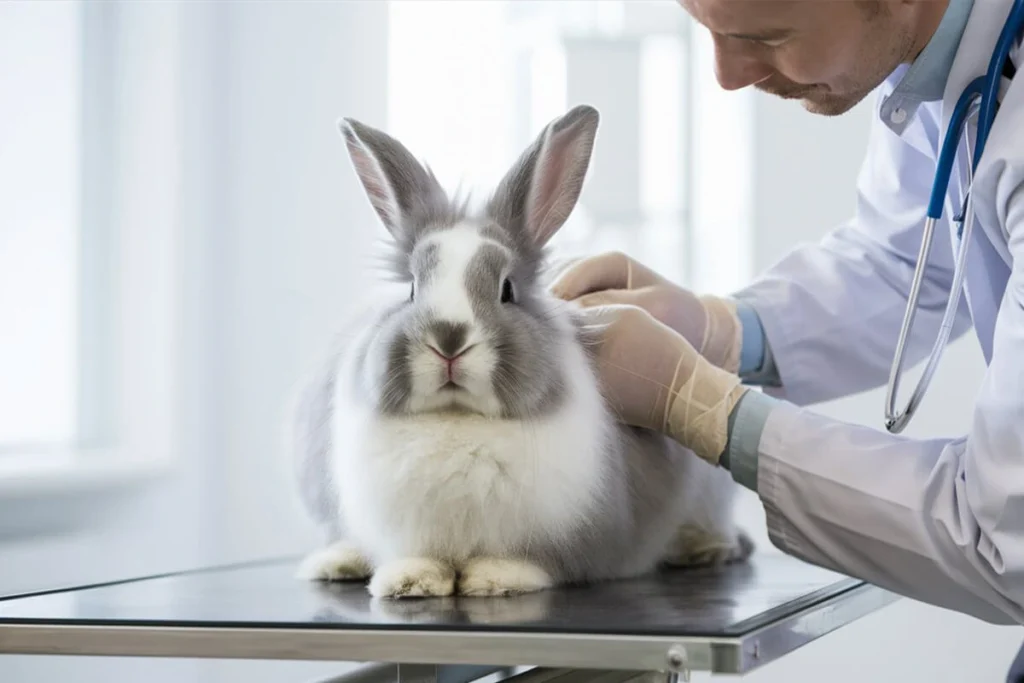
A rabbit-savvy veterinarian will perform a thorough physical exam, checking the ears, eyes, teeth, heart, lungs, and coat condition. They will also assess the rabbit’s weight and diet to ensure they are receiving proper nutrition. Unlike dogs and cats, rabbits require specialized care, so finding an experienced vet is crucial.
To locate a rabbit-savvy veterinarian, check the American Rabbit Breeders Association (ARBA) directory, local exotic animal clinics, or rabbit rescue organizations. Ask potential vets about their experience with fiber rabbits and their knowledge of conditions like wool block, dental issues, and GI stasis.
In addition to regular vet visits, monitor your rabbit’s health at home by checking their appetite, droppings, and energy levels daily. If you notice changes in behavior, unexplained weight loss, or any signs of illness, seek veterinary care immediately. Prompt medical attention increases the chances of successful treatment and keeps your rabbit healthy for years to come.
By staying proactive with regular checkups, proper grooming, and digestive care, you can ensure your Giant Angora rabbit remains happy, healthy, and thriving in your care.
Raising a Loving and Social Giant Angora Rabbit
Bonding with Your Rabbit
Building a strong bond with your Giant Angora rabbit requires patience, consistency, and gentle interactions. Since rabbits are prey animals, they naturally feel cautious around new people and environments. Establishing trust takes time, but once a bond forms, Giant Angoras become affectionate and enjoy companionship.
Start by allowing your rabbit to approach you on their own terms. Sit quietly near them and avoid sudden movements or loud noises that might startle them. Speak in a soft, soothing voice to help them associate your presence with comfort and security. Offering treats like fresh herbs, small pieces of apple, or banana encourages positive interactions. Over time, they will begin to associate you with positive experiences and will seek out your company.
Physical touch helps strengthen your bond, but not all rabbits enjoy being picked up. Instead of lifting them right away, let them get comfortable with gentle head pets and cheek rubs. Most rabbits love being stroked on their forehead, ears, and back. Pay attention to their body language—if they flatten their ears, flick their tail, or hop away, they may need more time to feel secure.
Spend quality time with your rabbit outside their enclosure by creating a safe, enclosed space where they can roam freely. Allow them to explore while sitting on the floor with them. Some rabbits will naturally climb onto their owners’ laps once they feel safe. Others may prefer sitting next to you while receiving soft pets.
The more time you invest in bonding, the more affectionate and trusting your Giant Angora rabbit will become. Many owners find that their rabbits follow them around the house, nuzzle them for attention, or even respond to their names over time.
Training and Socialization
Training your Giant Angora rabbit enhances their quality of life while strengthening your bond. Despite their fluffy and delicate appearance, these rabbits are intelligent and can learn basic commands, litter training, and even tricks through positive reinforcement.
Litter Training:
Start by placing a litter box in the area where your rabbit naturally eliminates. Fill it with rabbit-safe litter, such as paper-based or aspen shavings (avoid clay or clumping litter, which can be harmful if ingested). Each time your rabbit uses the litter box, reward them with a small treat and verbal praise. Consistency and patience will help reinforce good habits. If they have accidents outside the litter box, clean the area thoroughly to remove the scent and gently guide them back to their designated spot.
Basic Commands and Tricks:
Giant Angoras can learn their names and simple commands like “come,” “up,” and “spin” using treats as motivation. Hold a small treat near their nose and slowly guide them in the direction you want them to move. Once they complete the action, immediately reward them. Repetition and positive reinforcement will help them associate commands with rewards.
Socialization:
Exposing your rabbit to different environments, people, and gentle animals improves their confidence. If your rabbit feels comfortable, allow them to interact with trusted family members or other well-behaved pets under supervision. Always provide a safe escape route in case they feel overwhelmed.
Some rabbits enjoy agility training, such as jumping over small hurdles or running through tunnels. These activities provide mental stimulation and encourage exercise. Keep training sessions short and enjoyable to prevent stress.
Connecting with Rabbit Breeders and ARBA Communities
Joining rabbit communities offers valuable resources, networking opportunities, and support for raising a Giant Angora rabbit. Whether you’re interested in fiber production, breeding, or simply learning more about your rabbit, connecting with experienced breeders and organizations like the American Rabbit Breeders Association (ARBA) can be highly beneficial.
Finding Reputable Breeders:
If you’re considering adding a Giant Angora to your home, working with a responsible breeder ensures you receive a well-socialized, healthy rabbit. Look for breeders registered with ARBA or other reputable rabbit organizations. Ethical breeders prioritize health, temperament, and proper care, ensuring their rabbits are raised in a safe and loving environment. When speaking with a breeder, ask about their rabbits’ lineage, medical history, and socialization practices.
Attending Rabbit Shows and Events:
ARBA hosts rabbit shows, fiber festivals, and educational events where enthusiasts gather to showcase their rabbits, learn about different breeds, and connect with experts. Attending these events allows you to meet experienced breeders, gain hands-on grooming tips, and explore high-quality rabbit supplies.
Online Communities and Support Groups:
Joining online forums, social media groups, or local rabbit clubs connects you with other Giant Angora owners. These communities offer advice on grooming, nutrition, housing, and health concerns. Many breeders and fiber artists share their expertise on handling wool production and caring for high-maintenance coats.
By engaging with rabbit breeders and ARBA communities, you can expand your knowledge, build relationships with fellow rabbit owners, and ensure your Giant Angora rabbit receives the best possible care.
Conclusion
Raising a Giant Angora rabbit requires commitment, patience, and a deep understanding of their unique needs. Their luxurious wool, gentle temperament, and affectionate nature make them a rewarding companion, but they depend on proper care to thrive. Providing the right housing, nutrition, and daily interaction strengthens your bond and ensures their long-term well-being.
Grooming plays a vital role in keeping your rabbit comfortable and healthy. Their thick wool demands frequent brushing to prevent matting and wool block, which can lead to serious health issues. Learning proper grooming techniques not only maintains their stunning coat but also enhances their overall health. Shedding and molting cycles require additional care, and wool harvesting benefits both you and your rabbit when done correctly.
A well-balanced diet keeps your Giant Angora rabbit energetic and happy. Unlimited fresh hay, high-quality pellets, and nutrient-rich vegetables support their digestion and overall health. Monitoring their eating habits and litter box use helps detect early signs of illness, allowing for prompt intervention if needed.
Building a strong bond with your rabbit through gentle handling, training, and positive interactions encourages trust and deepens your connection. Socializing them early and introducing stimulating activities prevent boredom and promote a well-adjusted personality. Whether you are raising a Giant Angora for companionship or fiber production, their intelligence and affectionate nature make them a delightful addition to any home.
Connecting with experienced breeders, rabbit communities, and ARBA members provides valuable resources for proper care and ongoing support. By dedicating time, effort, and love to their care, you can raise a Giant Angora rabbit that not only flourishes under your care but also forms a lifelong bond with you in return.
Read More About The English Angora Rabbit Breed from Here
Pick A Nice and Unique Name for your Fluffy Rabbit Friend From Our 100 names Guide
Find Out More about Pets and Different breeds From HERE!
Discover the Best stuff for your Pet On Pet MD Official
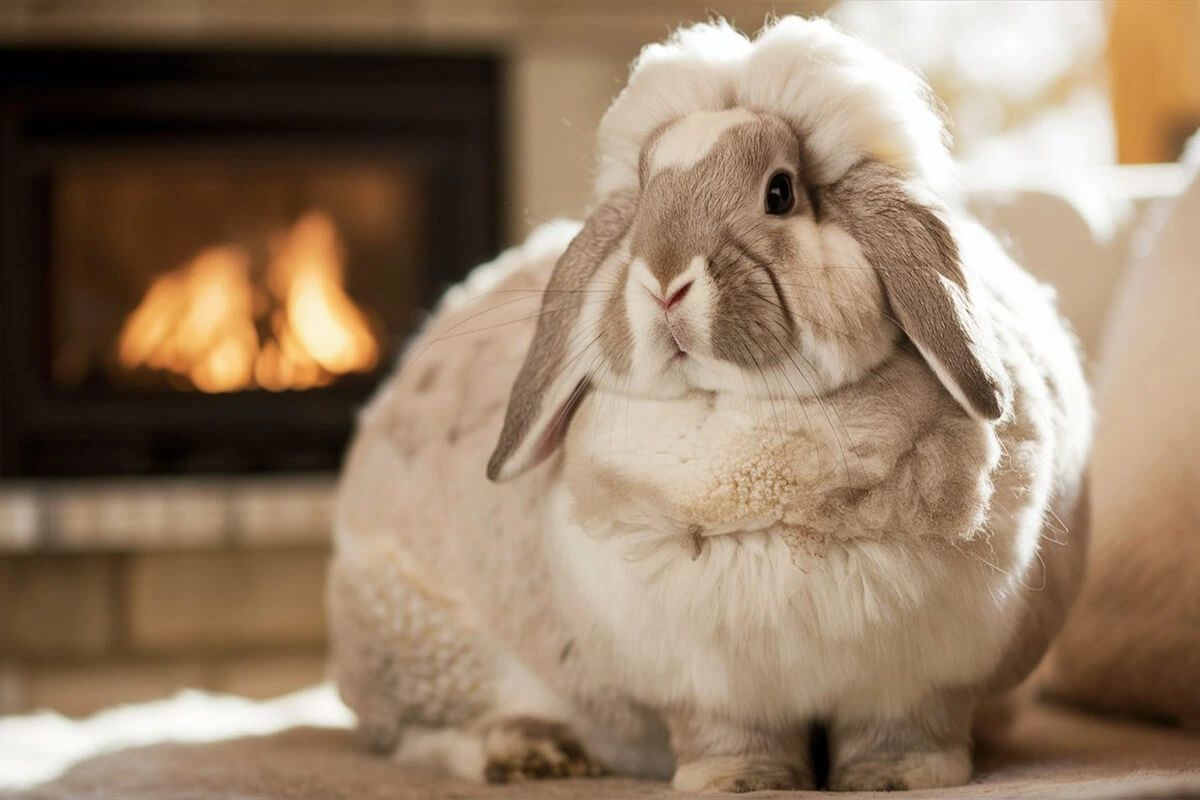
1 thought on “Learn How to Raise a Giant Angora Rabbit That Loves You Back”
Comments are closed.